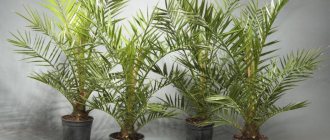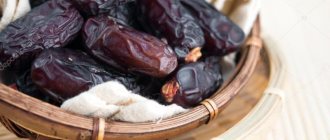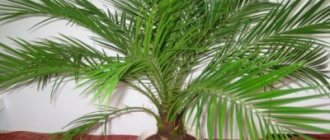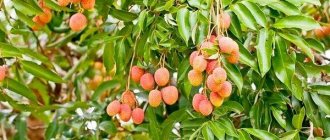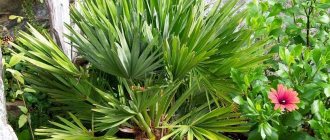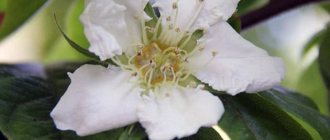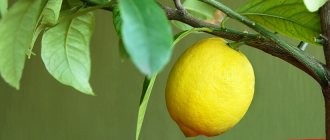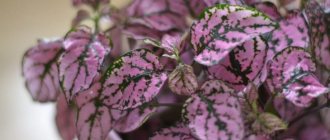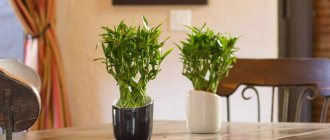Author of the article
Daria Vorontsova
Reading time: 12 minutes
AA
Many people tried to germinate a date from a seed and get a real date palm at home, but not everyone succeeded. However, it is not as difficult as it may seem. This palm tree is often grown as a house plant, because it adapts very well to ordinary home conditions.
Planting a date palm from a seed
Growing a date palm at home is not difficult. The first option is to buy seeds at a flower shop. Second, buy fresh or dried dates at the supermarket.
The first option is suitable for those who want to grow a specific variety of palm tree. However, it is important to remember that such seeds are very expensive, and their germination rate is not very high.
The second option is available to almost everyone. The plant will grow from the seed of both fresh and dried fruit. Only boiled fruits are not suitable.
You need to prepare at least a dozen seeds, since not all of them will sprout, and some of the sprouts will die immediately after germination.
The most suitable period for growing date palms from seeds at home is the end of winter and the beginning of spring.
What do we have to do?
1. Remove the pit from the fruit and carefully remove any remaining pulp.
2. Place in water for two to three days. We throw away the floating seeds, since it is the heavy ones that are viable, those that sink to the bottom. The water must be warm, and it must be changed daily (make sure that the fresh water is also warm).
3. Rinse the bone.
4. To increase germination, it is necessary to disrupt the integrity of the durable shell of the seed.
You can carefully cut it, you can carefully pierce the shell, you can pour hot water over the seeds (no higher than 80 degrees) or remove part of the shell with sandpaper.
5. Now you need to soak the seeds again. To do this, we either place them in water for two to four days, or wrap them in damp cotton wool. In the first case, you only need to change the water twice a day. In the second, we pour a little water into the bottom of a plastic container, wrap each seed in cotton wool moistened with water and put it in the container, then put it in a warm place. You need to make sure that the cotton wool and the bottom of the container do not dry out.
6. The swollen seeds are ready for planting.
Which soil and pot to choose
While the seeds are waiting in the wings in warmth and moisture, it is necessary to purchase or prepare soil.
Ready-made soil mixture for palm trees is sold in flower shops and in the relevant departments of supermarkets.
It’s easy to mix palm seed soil at home yourself. To do this, mix sand, sawdust and peat (1:1:1). Another option for the mixture is turf, humus and sand (also in equal proportions). The third option is a handful of coal, peat, sand and turf (1:1:2).
It is advisable to pre-treat the soil to protect the sprouts from problems with weeds, pests and diseases. You can calcine the soil in the oven or disinfect it with a weak solution of potassium permanganate.
The pot needs to be deep, but not wide. You cannot plant a palm tree in a large pot “for growth.”
For planting seeds, ordinary plastic cups with drainage holes are suitable.
What conditions are suitable for growing palm trees?
A prerequisite is warmth. A palm tree from a seed should be grown at home in a mini-greenhouse. This plant requires a constant humidity level of at least 40% (ideally 50%) and a strict temperature regime: in summer the temperature should not fall below 25 degrees and rise above 30.
The soil should be moist, but waterlogging should not be allowed, otherwise the roots will rot.
It is impossible to plant seeds horizontally, “on their side”. Only vertical planting is permissible; they must be buried one and a half times the height of the seeds themselves.
The container can be covered with glass. Moss can serve as a covering material.
Transfer
Young plants that have not reached the age of five are replanted annually, and those that are older are replanted if necessary, because this tree does not like to be disturbed. When replanting, proceed very carefully so as not to damage the root of the date palm. The best way to do this is to transfer the plant from an old container to a new one. The pot should be deep enough, as it has long roots, and each next pot should be 3 or even 4 cm larger in diameter than the previous one. If the old container for the palm tree still fits, but the soil has already lost its beneficial qualities for the plant, when replanting, you should carefully remove the top layer of the old substrate and replace it with fresh one. This is done once every six months.
How long does a date grow?
If the seeds were fresh, then you will be able to see the first shoots within a month. Dried seeds will germinate in two to three months.
The date grows for a very long time: feathery leaves appear only after five years. The first two years it resembles grass; the foliage begins to change only in the third year. And in the fourth or fifth year the first dissected shoots appear.
❀ Is it possible to get fruits at home?
This question is of interest primarily to beginners. Connoisseurs know that you won’t be able to get dates at home. The tree bears fruit only under natural conditions.
It can start at 6-8 years old. But for fruiting you need 2 plants - male and female.
However, how exotic this tree looks in the house, with its beautiful wide leaves. It can reach 2 meters in height.
It grows slowly. In three years, only 3-4 long narrow leaves appear. Only after a few years do the split branches grow.
Date palm care
The plant is demanding in terms of maintenance conditions: it quickly loses its decorative qualities in response to insufficient or excessive watering, excess bright light or shading.
In order for a tree to grow well at home, you should carefully monitor the temperature, lighting, humidity and follow the watering regime.
Lighting
Trees suffer from lack of light: the ideal place for them is near a window or on a balcony on the south and southeast side. Young palm trees (up to two years old) should be shaded from direct sunlight.
If only side light falls on the palm tree, you need to periodically turn the pot. Otherwise, the top will form asymmetrical.
At the end of spring and summer, you can take the pot or tub out into the fresh air (for example, into the garden). The tree overwinters indoors with additional lighting.
An abundance of light is especially important for seedlings.
Temperature
The date tree does not tolerate sudden temperature fluctuations. Comfortable temperatures for this plant are from 20 to 35 degrees in summer and not lower than 15 degrees in winter.
In summer, the plant can spend the night outside, but if there is a threat of frost, it must be brought home.
The tree should be protected from drafts at home and from strong winds in the fresh air. Stagnant air is also not good for the plant. It is advisable to take it out of the room during ventilation.
Watering
Dryness is detrimental to dates. It is necessary to water with warm water, which has stood for some time at room temperature. The earthen lump should not dry out even when it hibernates. Water every two to three days. If the air in the room is dry, it is worth watering the palm tree every day in the summer and once every two to three days in the winter. While the batteries are operating, you can cover them with a wet towel if you cannot move the pot. In summer, a container of water is placed near the date to humidify the air.
Excess water from the pan must certainly be drained so that the roots do not rot due to excess moisture.
It is important to spray constantly: both in summer, when the air is dry and hot for natural reasons, and in winter, when working radiators dry the air.
Formed leaves should be wiped with a damp cloth at least once a week.
Brief description of cultivation
- Illumination . Lots of bright sunlight.
- Temperature regime . In the warm season, the palm tree feels good at normal room temperature. In the winter months, it is kept cool - from 12 to 18 degrees.
- Watering . Moisten the soil moderately but systematically.
- Air humidity . During the hot summer months, it is recommended to moisten the foliage with a spray bottle and wipe them with a damp sponge. Once every 7 days you need to take a warm shower. In winter, the bush is removed away from operating heating appliances.
- Fertilizer . In the spring-summer period, once every 7 days the bush is fed with fertilizer for decorative deciduous plants or for palm trees. In winter, fertilizing is carried out once every 30 days.
- Rest period . In room conditions it is not pronounced. However, it is recommended to provide the palm tree with rest for 4-6 weeks in winter.
- Transplant . The procedure is carried out every year until the bush is 5 years old. Then it is transplanted only in case of emergency, and the less often the better.
- Reproduction . Seeds.
- Pests . Scale insects, spider mites and mealybugs.
- Diseases . Leaf spots, pink rot and root rot.
- Bloom . It is grown indoors as an ornamental foliage plant.
Date palm: cultivation. The benefits and harms of the plant
How to replant correctly
It is preferable to replant in spring. A young tree is replanted every year, and older than five years - less often: once every three years, or even once every five years.
It is important to adhere to the rules so that the date palm at home retains its decorative qualities:
- The roots of a palm tree grow mainly not in breadth, but in depth. Therefore, the new container should be noticeably deeper than the old one.
- If it is not possible to carefully remove the roots, the old container must be carefully broken: damage to the roots is detrimental to the tree.
- The pot must have drainage holes. In addition, it is worth putting a drainage layer on the bottom (for example, expanded clay).
- Replanting a palm tree means carefully rolling it along with a lump of earth - no need to clear the roots from the soil.
- The trunk of the plant does not need to be buried. The exposed root collar can be mulched with moss (coarse-fiber).
Formed palm trees in large tubs are not replanted. They should be fed and the top layer of soil periodically updated.
How a date tree grows in nature and at home
The date tree is a plant belonging to the Palm family, included in the group of pinnate palms, like the related Hamedorea and Howea. Under natural conditions, the culture is found in regions with tropical and subtropical climates. The birthplace of the date, like all palm trees, is considered to be India and Africa. On the European continent they grow well and bear fruit in the south of Spain.
In its natural environment, the tree can grow up to 30 m in height and produce several large clusters per season, on which hundreds of delicious fruits ripen.
This is interesting! The age of the pinnate palm tree growing in natural conditions can reach 150 years!
The crop has a strong trunk, so it is impossible to simply shake it to collect fruits falling from the branches. To harvest dates, they climb the tree itself and cut off clusters of fruits that look like filled string bags.
The indoor date palm has more modest parameters. It rarely grows more than 2 m in height and has less spreading leaves. The trunk of domestic palm trees is low, covered with “scales” and hairs characteristic of many palm trees.
Young specimens grow relatively quickly, so they will have to be replanted often. And when the tree “matures”, it will be possible to change the flowerpot less often.
Palm diseases
Unbalanced care can lead to plant diseases. It is important to help in time to prevent the palm tree from deteriorating and dying.
The tips of the leaves dry out
If the plant is not moistened by spraying and removing dust with a damp cloth, the tips of the leaves begin to dry out. It also dries out if there is insufficient watering. Take care to moisten the soil and air.
This problem can also occur as a result of a lack of minerals, as well as exposure to drafts.
Drying of the tips can also be the result of the plant being shaded: make sure that the date palm is not in the dense shade of another plant or some object for a significant part of the day.
The leaves are turning yellow
The cause of yellowing is increased dryness. A change in color indicates that the palm tree is not sprayed (which means the required level of humidity is not provided) and is not watered regularly (the earthball dries out).
Another possible reason for leaves drying out and changing their color is frequent replanting. Delicate roots do not have time to adapt to new conditions - and the Phoenix can shed its foliage.
The foliage is darkening
Palm leaves darken from waterlogging, and at the same time the trunk may soften. You must immediately check the roots of the plant by carefully removing it from the pot or tub.
If the roots also become dark and softened, then the plant can no longer be saved.
If there are living roots left, then you need to try to save them. To do this, you need to remove dead roots, sprinkle the cuts with coal, transplant the palm tree into fresh soil and strictly adhere to the watering regime.
Stopping growth
There are two main reasons for growth failure:
- Excessive soil acidity: if the acidity level exceeds 7 pH, then there is a lack of microelements that ensure the growth and development of the palm tree.
- Hypothermia: if the temperature drops below 17 degrees, the root system of the palm tree practically stops development. Therefore, it is advisable that the temperature in the room does not fall below 20 degrees.
Possible problems
Possible problems that arise when growing palm trees include:
- growth cessation depends on the temperature of the soil. At a temperature of +16...+17°C, the root growth of the plant slows down;
- edge burn of leaves - burnt edges of leaves are difficult not to notice, which is a signal for a complete or partial change of soil;
- Magnesium deficiency - the first signs are visible on old leaves. With this problem, wide yellow stripes form on them along the edge of the plate. The middle of the leaf is green;
- copper toxicity - ellipse-shaped spots on the leaf blade that resemble signs of fungal spot (a disease of palm leaves). In such a situation, it is necessary to avoid the use of drugs containing copper.
Types of date palms with photos
More than one and a half dozen types of dates are known, but the following four are the most popular:
- Canary
- Palmate
- Robelena
- Forest.
Date canarian
In the rocky areas of the Canary Islands, in the shade of this type of date palm, you can relax in company: it reaches fifteen meters in height with a trunk circumference of one meter. Home-grown Canarian dates are noticeably smaller.
This palm has large, feathery leaves that are dark green in color. It takes a long time to grow: it will take five to seven years to reach a height of one and a half meters.
You can buy Canarian date palm seeds in a specialty store.
For this species, it is important to have plenty of light, ventilation, a significant layer of drainage in the pot, constant spraying and regular watering.
Date palmate
Grows in warm regions: oases of the Nubian and Libyan deserts, in the Middle East, on the Arabian Peninsula, etc.
The fruits of this variety are exported all over the world. From Algeria and Tunisia, fresh and dried fruits are transported to all continents. It can be found in any supermarket and grown from seed.
In its natural habitat, the tree is amazing in size: it grows up to thirty meters. It has an elegant trunk and spreading (up to 6 m) leaves, arranged in a bunch at the top.
In a greenhouse, apartment or office, the tree grows slowly, but can easily reach a height of two to three meters. After seven to ten years, specimens grown at home have to be transplanted into tubs or massive pots and taken outside. It is convenient to keep only young plants at home.
Regular watering and spraying with warm water is important for this species.
Date Robelena
This species is native to Southeast Asia: Laos, Vietnam, central and southern China. Robelena is squat and multi-trunked. It is relatively low: its height rarely reaches three meters, usually one or two meters with a trunk circumference of 10 cm.
Due to its decorative qualities and relatively modest size, it is often grown in botanical gardens and greenhouses. Robelena is also popular for breeding at home.
It is important to provide the plant with abundant watering, significant air humidity and light. In summer, it is worth placing a pot of Robelena near a south window or on a balcony (however, in the hottest weather, it should be protected from direct sunlight). In winter, this species needs additional lighting: Robelena's daylight hours should last at least 12 hours.
Forest date
Forest is native to Eastern India. There you can find forests of this plant, although palm trees usually do not form forests. Another interesting feature of this species is that sugar is made from its juice.
In its natural environment, this is a huge tree up to 12 meters in height with spreading, arched, feathery leaves.
Date trees decorate the interior or greenhouse, can be used for zoning a room, and add freshness to an apartment or office, adding a touch of exoticism. It is easy to care for, and a tree you grow yourself will make your home or workplace more comfortable.
